Film Retrospective: “Floating Clouds … The Cinema of Naruse Mikio” — Dedicated to Women’s Passions
By Betsy Sherman
Film scholars, programmers and the many filmmakers influenced by Naruse Mikio value him as having crafted well-rounded portraits of women and their lives across decades of Japanese cultural changes.
Floating Clouds: The Cinema of Naruse Mikio. At the Harvard Film Archive, Cambridge, July 5 through November 3. Films in Japanese with English subtitles.
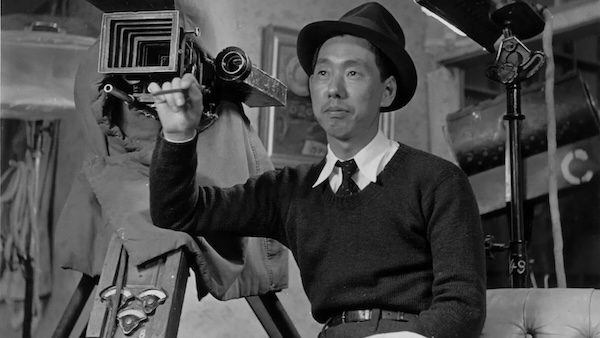
Naruse Mikio. Photo: Japan Society
Another summer, another invigorating retrospective at the Harvard Film Archive. This year, it’s a series devoted to one of the lesser-known masters of Japan’s studio era, Naruse Mikio (note: the HFA and this article are using the form family name followed by given name). The 2025 celebration, marking the director’s 120th birthday, provides a bounty for the summer months and strides well into the fall.
For area cinephiles, the HFA retrospectives are a must-see in part because they bring back movies that haven’t been seen in the Boston area for decades. This series includes titles that will be making their New England premieres. In 2005, the traveling series Mikio Naruse: A Centennial Tribute — split between the HFA and the Boston Museum of Fine Arts — was a revelation with its 18 films. The master made 88 films in all, although much of his work has been lost (as has most of Japanese prewar cinema). This year, we get 45 Naruse films (44 to be shown on 35mm film, one on 16mm). And true to HFA tradition, there will be a commemorative Naruse T-shirt. The program is co-presented by The Japan Foundation and the Berkeley Art Museum & Pacific Film Archive.
Film scholars, programmers, and the many filmmakers influenced by Naruse (1905-1969) value him as having crafted well-rounded portraits of women and their lives across decades of Japanese cultural changes. The director’s contemporaries were Mizoguchi Kenji (himself famed for spotlighting the oppression of women) and Ozu Yasujiro. Kurosawa Akira came a few years later; he was Naruse’s assistant director on the 1937 Avalanche. Like Ozu, Naruse explored the details of family and home within the lower middle class (a genre known as shoshimen-eiga), although he was not as strictly ensconced in the genre, or as narrowly wedded to specific techniques as Ozu was.
Naruse and his female characters recognized their plight, and their powerlessness in it, but he and they also envisioned a chance for independence. Catherine Russell, in her comprehensive 2008 study The Cinema of Naruse Mikio: Women and Japanese Modernity writes of the taciturn director, “He produced a remarkable body of films dedicated to women’s passions, disappointments, routines and living conditions, but he made remarkably few comments about his interest in women’s characters or women’s culture.” In the same vein, she contends that Naruse, “in his cinema, if not in his personal life, seems to understand the emotional terrain that is ostensibly the province of women.”
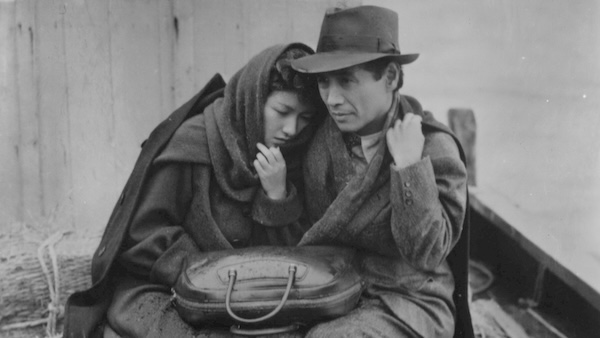
A scene from Naruse Mikio’s Floating Clouds. Photo: HFA
Kicking off the series is the film that shares its title, the 1955 Floating Clouds (playing July 5 & 6, September 19). Actress Takamine Hideko, who made 17 films with Naruse, gives a stunning performance in a complex role. As a melodrama of thwarted love, the film is devastating. Author Russell finds further resonance: “It was a rare film in 1955 that dealt so squarely with the sorrow of a defeated nation …” Protagonist Yukiko, who sometimes speaks in voice-over, is met in the numbed present of the war’s aftermath. She wears men’s clothes, trudging through the damaged city, searching for her married lover from a wartime posting. A sun-drenched flashback finds her at age 22, having arrived in scenic French Indochina to be a typist for a team from the Japanese Forestry Administration, of which the 40-ish Tomioka is a member. Their affair involved promises on his part to leave his wife.
Their eventual reunion is gloomy, awkward, frustrating. The phlegmatic Tomioka is at best ambivalent (actor Mori Masayuki is skillful at being bottled-up). The film takes Yukiko, as she flees poverty, through situations and milieus that reflect her inner state, and that of society. These include being the kept woman of an American GI and later the mistress of her brother-in-law, who years earlier raped her. He now runs a religious con and she becomes his bookkeeper — who runs off with the profits. Yukiko’s obsession with Tomioka never abates; their affair continues in fits and starts, usually resulting in Tomioka cheating on her with a younger woman. The strains on her emotions and her body take their toll. This description may make the film sound like the story of a sympathetic woman put through the wringer — or of a masochist. But it’s a combination of committed acting and the disciplined psychological realism of the script and direction that make Floating Clouds into such an impressive achievement.
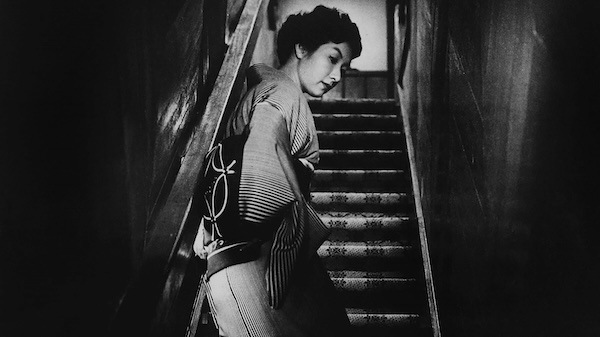
A scene from Naruse Mikio’s When a Woman Ascends the Stairs. Photo: HFA
I’ll elaborate from here on some of Naruse’s postwar films starring the director’s prized actresses, beginning with another Takamine Hideko classic. Although it won’t arrive on the HFA screen until August (8 & 17), get ready for the wonderful 1960 When a Woman Ascends the Stairs. In a way, it’s as dark in outlook as Floating Clouds, but it’s also riveting in the mold of director Douglas Sirk’s melodramas from the ’50s. With its jazz score and widescreen black-and-white look at Tokyo’s bar scene, the film has a high coolness quotient. It fits in with Naruse’s practice of chronicling marginalized women who toil in the “water trade” (Mizu-shōbai in Japanese), such as in bars or cabarets, or as geisha or entertainers.
Takamine Hideko shows grit and vulnerability as Keiko, called Mama-san by the gaggle of winsome hostesses she supervises at Bar Carton, a second-story bar in the swingin’ Ginza district. The 30-ish widow is at a crossroads: it’s time for her to open her own bar, but to do so she needs a rich patron, to whom she’d be beholden sexually. In voice-over, she explains the code whereby she must treat her customers like lovers, but never succumb to their advances, or else she’d be perceived as cheap.
Naruse sums up the nature of Mama’s life by arranging a still life of a faux-fur purse and an abacus. Mama’s increasingly precarious high-wire act requires her to present different faces to the different people in her life; soon she starts breaking her carefully worked-out moral precepts. Hiding a myriad of stresses beneath her gay exterior, Mama suffers a fate that seems uniquely Naruse-an: she develops a stomach ulcer. It’s hard to imagine an Ozu or Kurosawa character — endowed with the ability to accept fate, or to rage against the machine, respectively — ending up with such a nagging reminder of her daily humiliation.
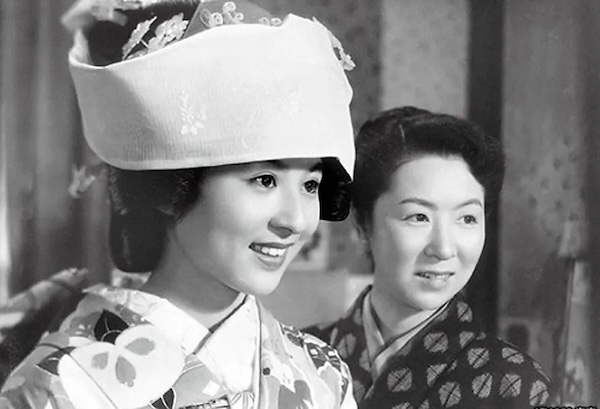
A scene from Naruse Mikio’s Mother. Photo: HFA
Naruse was born in 1905 in Tokyo, to a poor family. His parents died when he was young. After dropping out of school at 15, he worked briefly as a mechanic, then got a job as a prop man at Shochiku film studio. It took 10 years before the studio gave him a chance to direct. Japan’s industry transitioned to sound cinema in the mid-’30s, so Naruse’s formative period was in the silents. He debuted with the 1930 Mr. and Mrs. Swordplay, a lost film (Russell lists 24 films shot during Naruse’s silent period; only five survive).
Not much is known about the director’s personal life, except that in 1936 he married Sachiko Chiba, an actress who appeared in some of his films. That marriage ended in 1942, and he married again later. Even people who worked with him thought him a cipher. Accounts peg him as a loner, the type who would sit at the end of the bar and observe the behavior of others. Just as his work is tinged with pessimism, his most salient quotation is: “From the youngest age, I have thought that the world we live in betrays us; this thought remains with me.” Naruse died on July 2, 1969, of colon cancer, at age 63.
Japanese star Nakadai Tatsuyo (Harakiri, Ran) talked about Naruse in a 2005 interview included on the Criterion DVD of When a Woman Ascends the Stairs (he appeared in that movie and Untamed [July 11 & 13] early in his film career). He said the director was a quiet man who’d whisper softly in the actor’s ear on set, and that he cared less about how you read a line than about where your eyes were looking. He recalled that, for a two-person shot, Naruse would have one actor do all his or her shots first, followed by the other actor after the lighting was reset. Nakadai saw that as a sign of confidence, that the director had the vision of the edited footage in his head. He called Takamine Hideko his “best teacher” as he made the transition from stage to film acting.
Two of the director’s principal screenwriters during his postwar period were women, and he found a kindred spirit in the novelist Hayashi Fumiko, whose vision was also on the gloomy side. He adapted six of Hayashi’s works to the screen, including Floating Clouds and her autobiography A Wanderer’s Notebook, aka Her Lonely Lane (September 22).
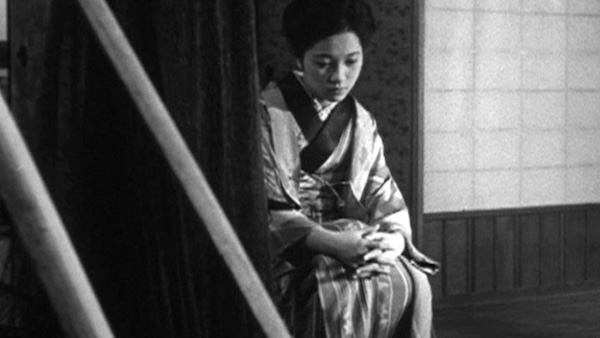
A scene from Naruse Mikio’s No Blood Relation. Photo: Criterion
The HFA will show the five extant silents on October 4 and 17, all with live musical accompaniment by pianist extraordinaire Robert Humphreville. The earliest, Flunky, Work Hard! (1931), about an insurance salesman and his bratty son, was called a “slapstick tear-jerker” by film historian Audie Bock. The others are more solidly dramatic. In them, several “moga” — modern girl — characters are contrasted with traditional wives and mothers. In the HFA notes, Kelley Dong calls No Blood Relation (1932) “an excellent early exemplar of Naruse’s interest in the relationship between love and money …” Like Ozu, Naruse was influenced by American and European films. Flunky contains a montage of an oncoming train that shows the influence of Soviet editing techniques.
Naruse left Shochiku for the P.C.L. studio just as sound technology arrived. His prewar and wartime sound films covered a range of subjects. He tried to avoid making period pieces, so most of his work was contemporary. When he could, he stuck with the lower-income characters with whom he identified. His first talkie was the 1935 Wife! Be Like a Rose! (August 23), which starred his wife-to-be and was one of the first Japanese films to receive a theatrical release in the United States. Naruse made a higher proportion of films with male protagonists during the late ’30s and ’40s, of which Japanese critics approved. However, he fell into a commercial slump and a personal funk because he took on studio assignments for which he didn’t feel suited (Naruse was known for not pushing back against his bosses).
Naruse freelanced for a bit, but in the ’50s settled in at P.C.L.’s successor, Toho. He began a particularly fruitful stage of his career in 1951, when he and screenwriter Kishi Matsuo tackled a subject that had been percolating in his mind for a while. Ginza Cosmetics (October 31) stars one of the great actresses of Japanese cinema, Tanaka Kinuyo, best-known for her tragedian performances for Mizoguchi (a 2023 HFA series showcased her work as an actor and director). The film is a milder precursor to When a Woman Ascends the Stairs, without the noir feel and with a domestic component. Tanaka plays Yukiko, middle-aged hostess at the Bel Amie geisha bar and single mother to a young son. Though she manages to keep her equilibrium, Yukiko is buffeted — figuratively and at times literally — as she endeavors to assert herself in a man’s world. The eternal grind of cajoling money from patrons is bad enough, but Yukiko faces defeat in merely having to handle a wayward customer who’s gotten drunk but says he has no cash to pay. There are nice, colorful touches, such as the boy traipsing through the neighborhood and the women’s competition over an intellectual young man.
Naruse and Tanaka scored another success with the 1952 Mother (July 19 & 27). Told from the point of view of a teenage girl, the story focuses on how her family deals with the deprivations and obligations in the postwar urban ruins. The daughter extols her loving mother’s kind eyes (Tanaka is noble, but not overbearingly so, as the mother). The tribulations include the effort to reestablish the dry cleaning and dyeing business run by the parents before the war: in this economic climate, self-sufficiency seems out of reach. Even though losses and absences figure prominently in the drama, there are lighter moments: an emphasis on hope emerges with the younger generation. Aesthetically, Naruse creates an interesting visual fusion of time and space by shooting the house from certain angles in which the rooms look like frames within frames. It’s a pictorial nod to the varying configurations of the family as time passes.
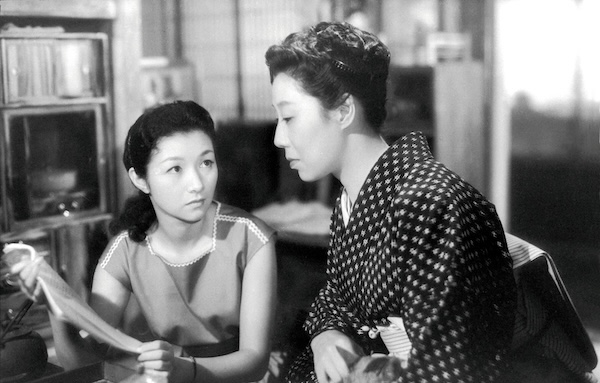
A scene from Naruse Mikio’s Flowing. Photo: HFA
Tanaka has an important supporting role in the 1956 Flowing (August 23 & 25), as the newly hired maid in the headquarters of a prestigious but failing geisha house. There are a multitude of female personalities in this work, and Naruse includes lore about the geisha trade, past and present (music and dances are performed). In a sense, the movie is about sex, but it doesn’t feature it. Tanaka, as a “regular” working woman, is the observer in the film; even though she’s of a different background, she respects and takes a maternal role toward the girls who pass through the house. Yamada Isuzu is the madame who’s embroiled in controversy, and Takamine Hideko is outstanding as her daughter, a practical young woman who knows she doesn’t want to join her mother’s business but doesn’t yet know what’s in store for her.
The beloved star of many Ozu masterpieces, Hara Setsuko, made four movies with Naruse. In the 1951 Hayashi adaptation Repast, aka A Married Life (September 27 & 29), she plays a housewife taken for granted by her white-collar-drone husband (Uehara Ken), whose salary barely pays the bills. The strength of the five-year-old marriage is tested by a visit from her husband’s cutie-pie niece from Tokyo, who chooses the couple’s cramped Osaka digs as a refuge from her parents and prospective groom. The husband does little to rebuff his niece’s flirtations, prompting the wife to run back home to mother, where she reflects on the dreams of her youth. Hara’s laugh, familiar from her Ozu films, here functions like steam spurting out of a pressure cooker. Everywhere, she’s reminded of her shabby existence. In Ozu, a shot of a clothesline may serve as a reassuring example of the backdrop of everyday life. In Naruse, a clothesline is a clothesline, on which our underthings are hung, exposed for all to see. Hara also stars in the 1954 Sound of the Mountain (July 7 & 18), the 1956 Sudden Rain (July 5 & 13) and the 1960 Daughters, Wives and a Mother (July 25).
Naruse gave actresses often seen in supporting roles a chance at lead parts. Awashima Chikage starred in the 1958 Summer Clouds (August 4 & 10), Naruse’s first film in color and in the Toho-scope widescreen format. The story centers on a working widow and her extended family. Yae comes from a long line of rice farmers. Naruse takes advantage of the rural setting to shoot picturesque vistas of the crop fields. But he puts a cautionary spin on farming — through the eyes of Yae. She’s stuck taking care of her ungrateful mother-in-law as well as tilling the soil. The land isn’t a bountiful mother; it’s more like a greedy baby demanding to be suckled. Yae finds an outlet in writing, and relief from her loneliness is supplied by an affair with a married reporter. As a counterbalance to the characters who long to flee to the city, there’s Yae’s nephew Hatsu and his fiancée Michiko. These two are so gung-ho about farming, they’re like refugees from a Soviet film.
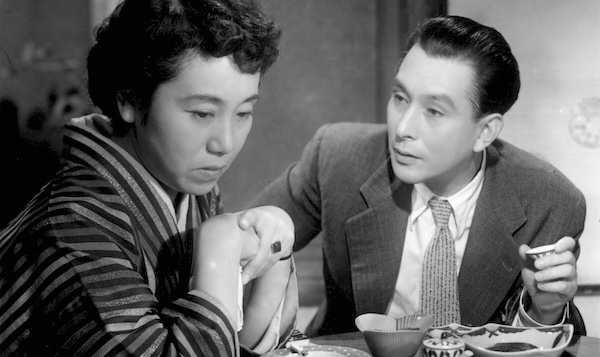
A scene from Naruse Mikio’s Late Chrysanthemums. Photo: HFA
Finally, character actress Sugimura Haruko gets her time to shine in the 1954 Late Chrysanthemums (September 26 & 28). She’s the Agnes Moorehead of Japanese cinema, perennially cast as the busybody neighbor or judgmental aunt. She plays Kin, the queen bee among four former geishas. A moneylender who’s raking it in from savvy real estate deals, Kin collects rent from her “sisters,” and exerts pressure if it’s not forthcoming. The smug, vain Kin is happy to take the walk from her comfy house to the cramped alleyways of her former colleagues’ neighborhood, and parade herself in front of Nobu, who owns a small bar with her husband, and the down-and-out widows Tamae and Tomi. Each widow has a grown child unable to support them. Tamae is hampered by illness, the feisty Tomi by addictions to alcohol and gambling. Naruse keeps pity for them at bay. Their resistance to Kin stands in for resistance against the rotten system that has left no place for them as they age.
Kin is put forward as many things, but not as a villain. For one thing, she’s thriving through her wits, and, for another, she’s the rare older woman character who expresses her sexual desire. Sugimura is priceless depicting Kin as she waits for her long-ago patron/lover to make a visit; she gussies herself up and practices her shamisen-playing. But the visitor is unexpectedly cold. While chatting, he describes his business world as “eat or be eaten”; he then cuts to the chase and asks for a loan. Kin gives the man the boot, and burns his photo. Kin’s appropriation of his words is emblematic of Naruse’s clear-eyed cinema: “’Eat or be eaten’ isn’t only for men!”
Betsy Sherman has written about movies, old and new, for the Boston Globe, Boston Phoenix, and Improper Bostonian, among others. She holds a degree in archives management from Simmons Graduate School of Library and Information Science. When she grows up, she wants to be Barbara Stanwyck.


What a great, comprehensive article about a wonderful retrospective!